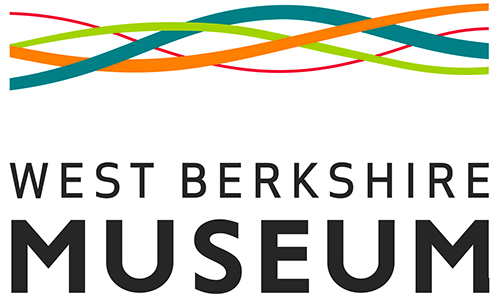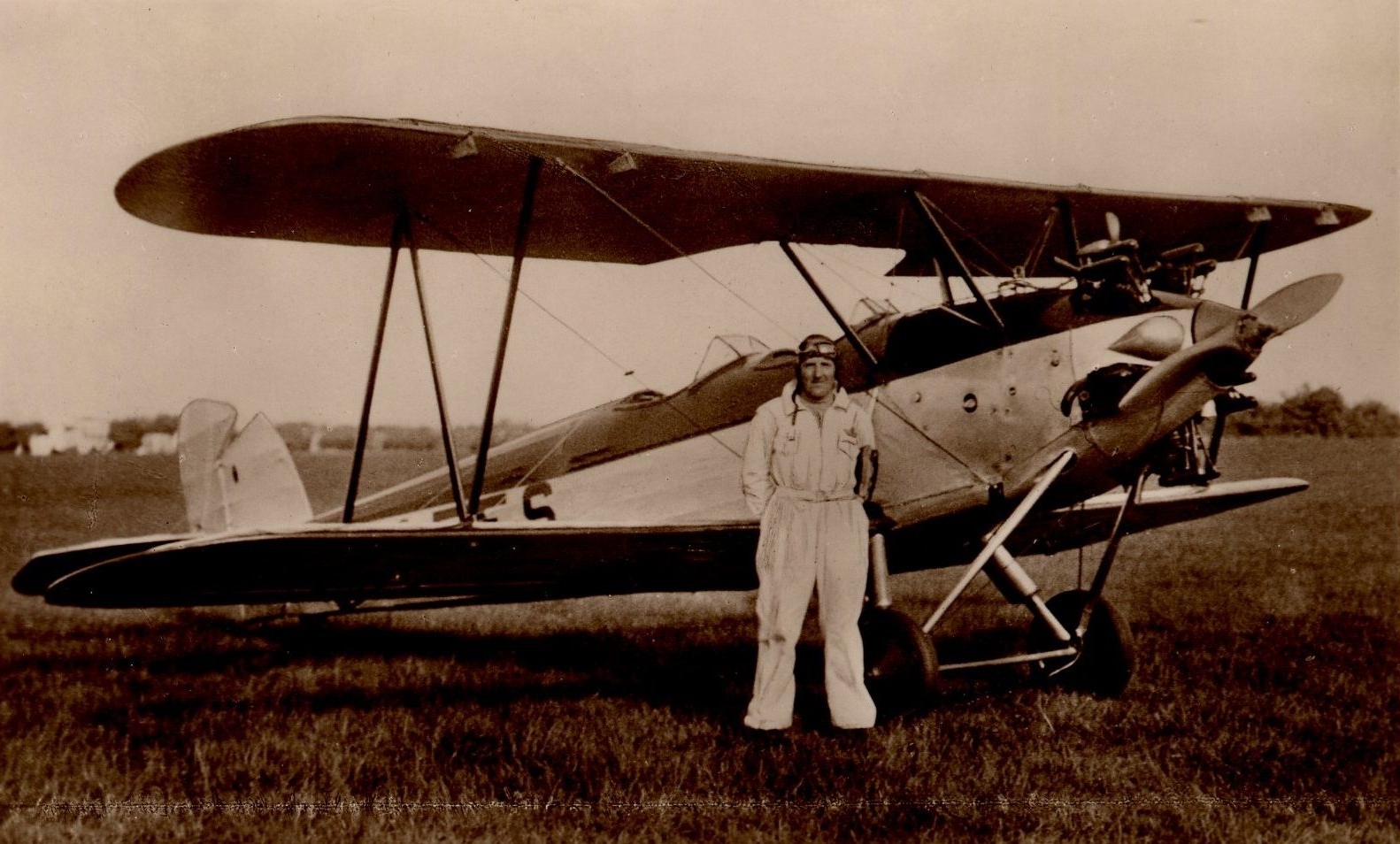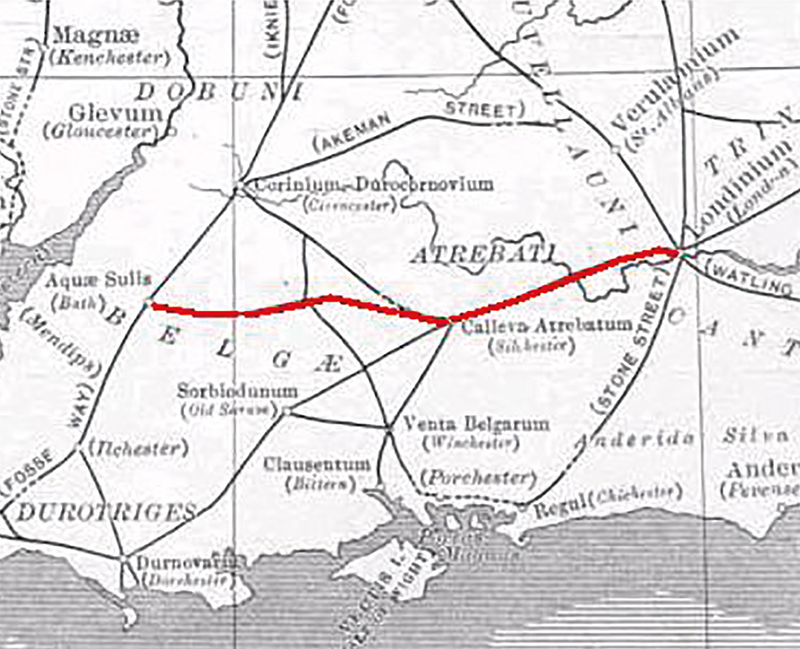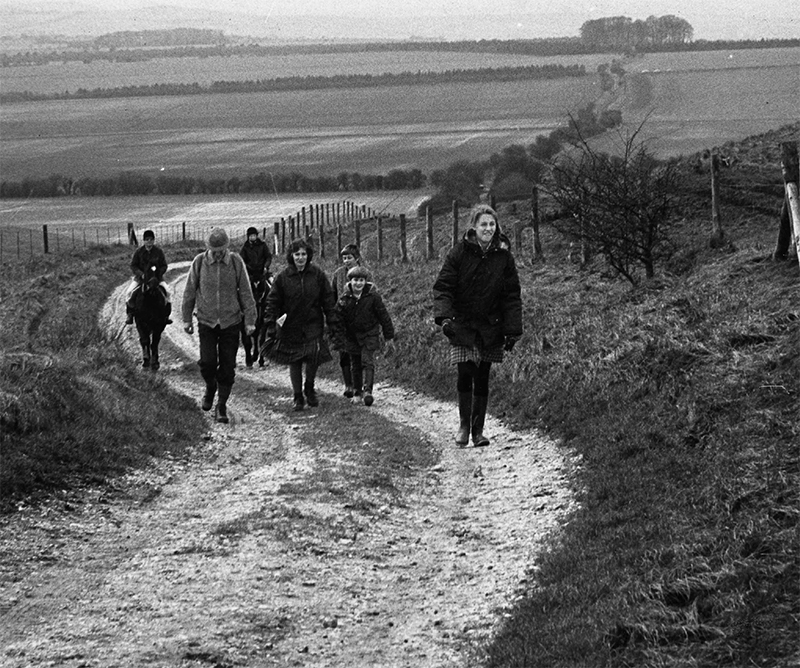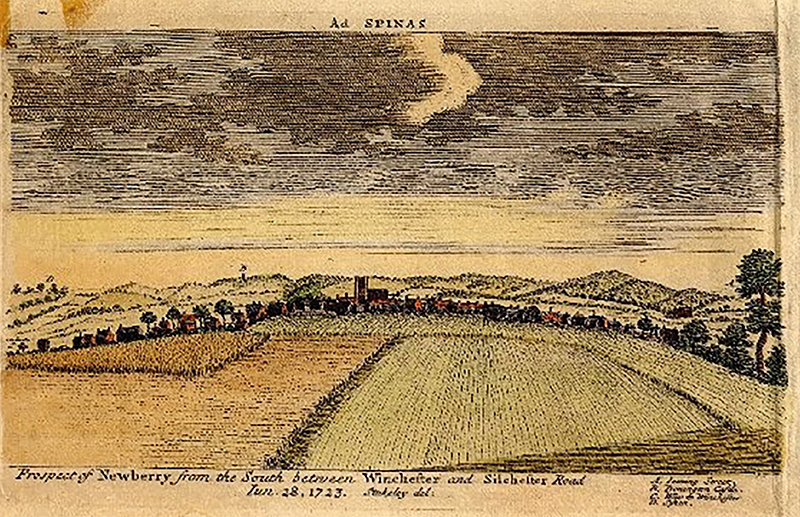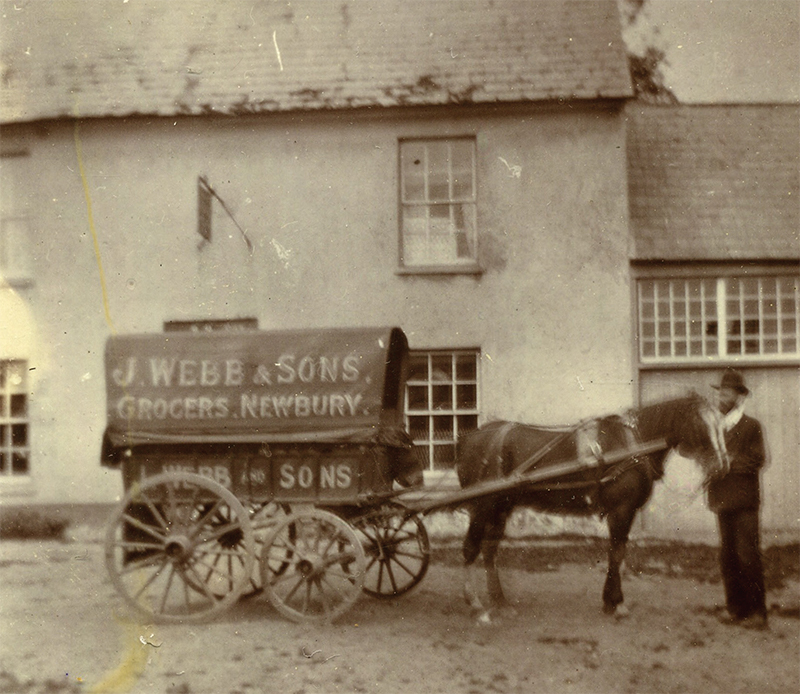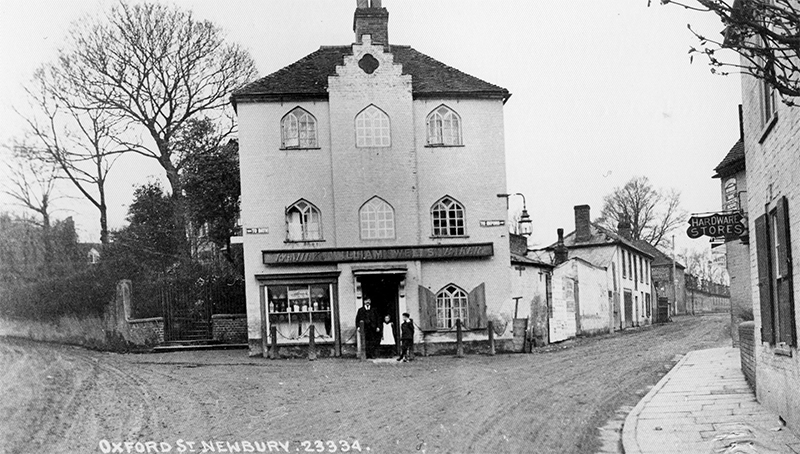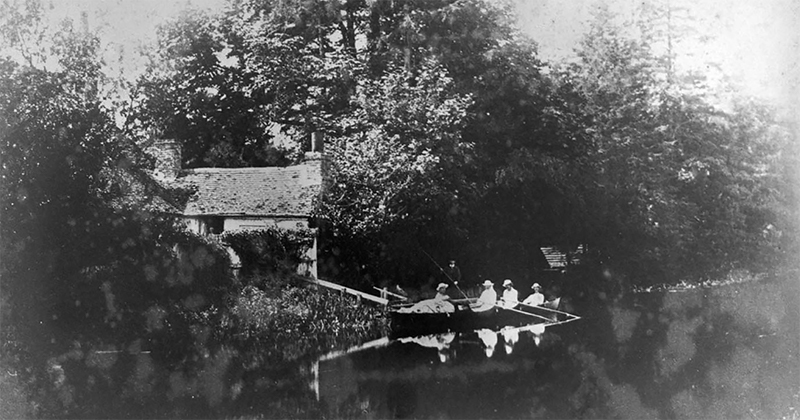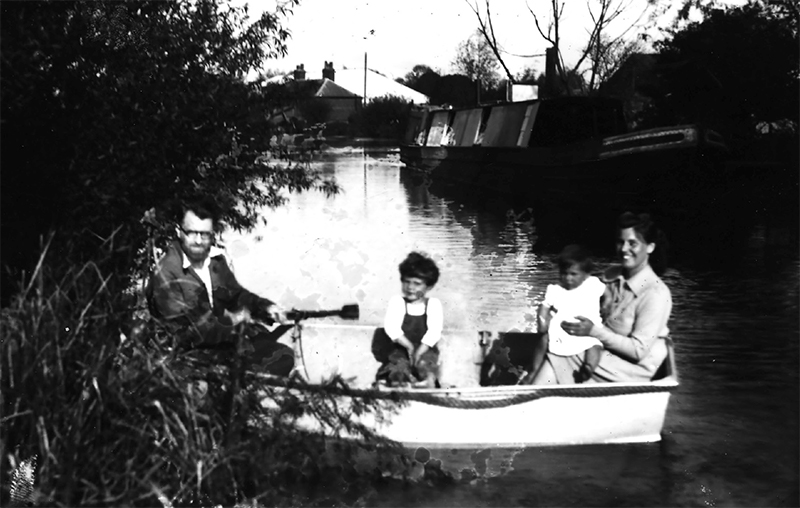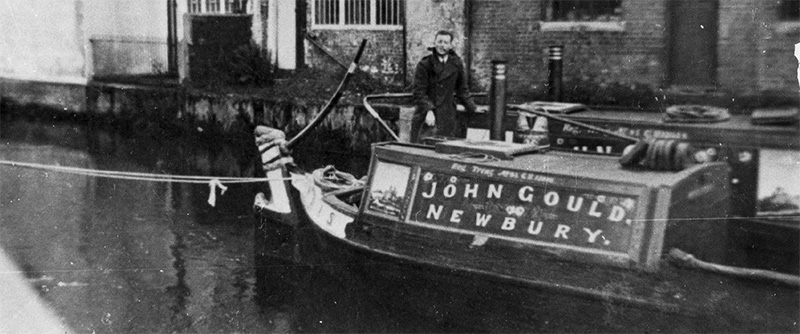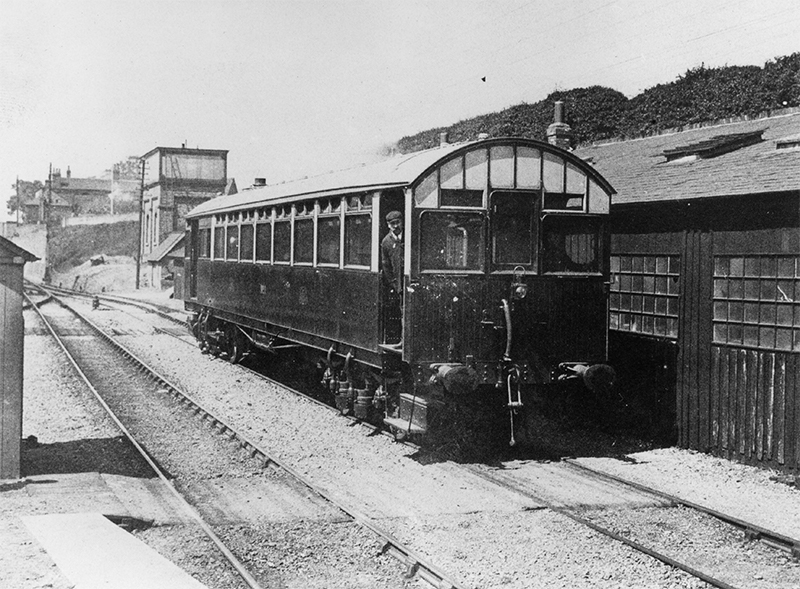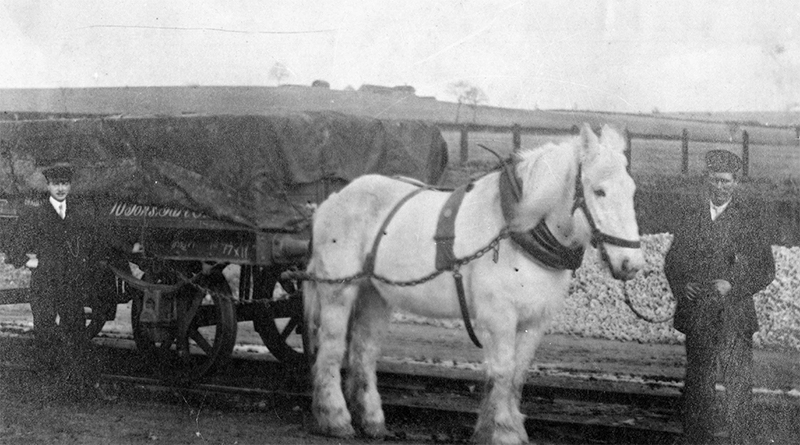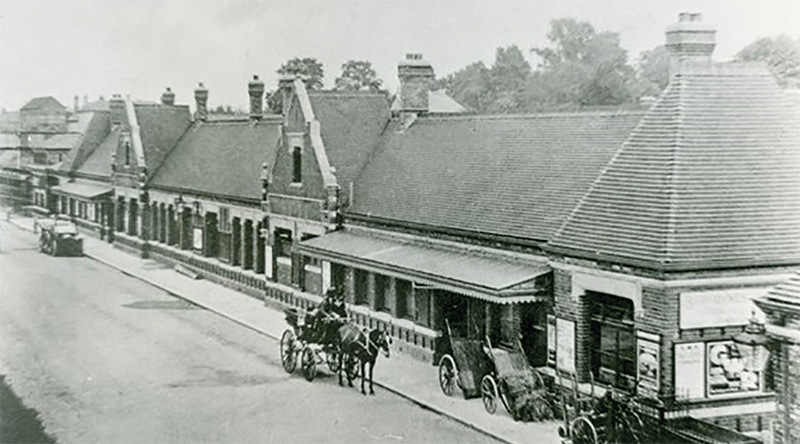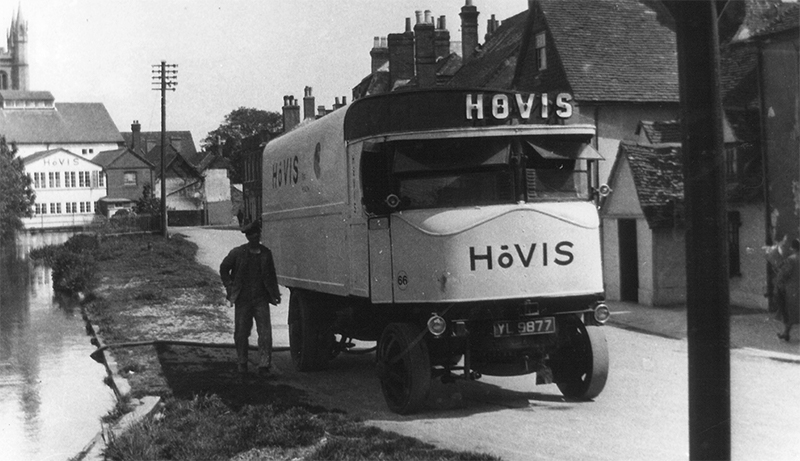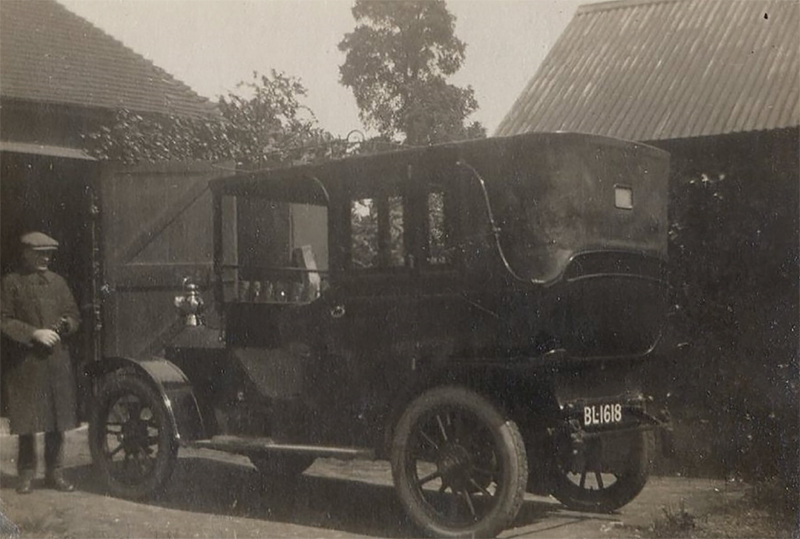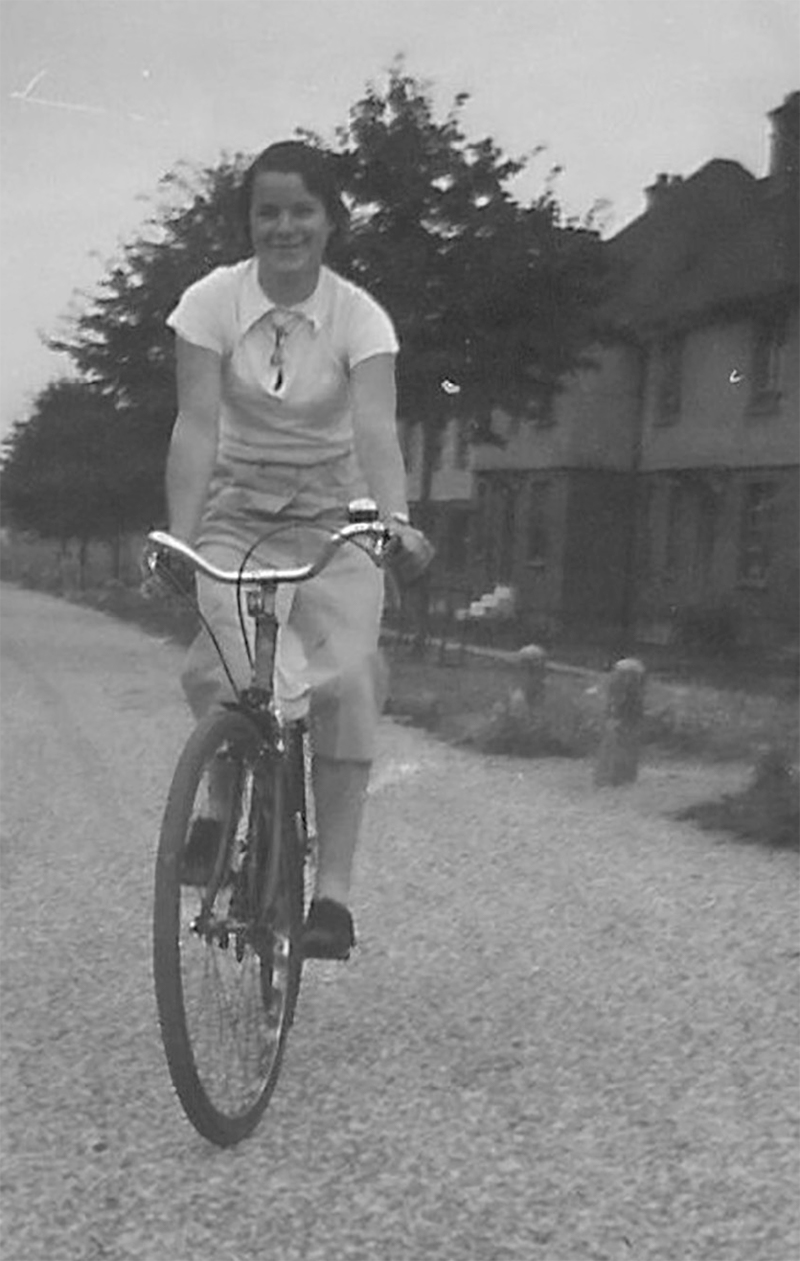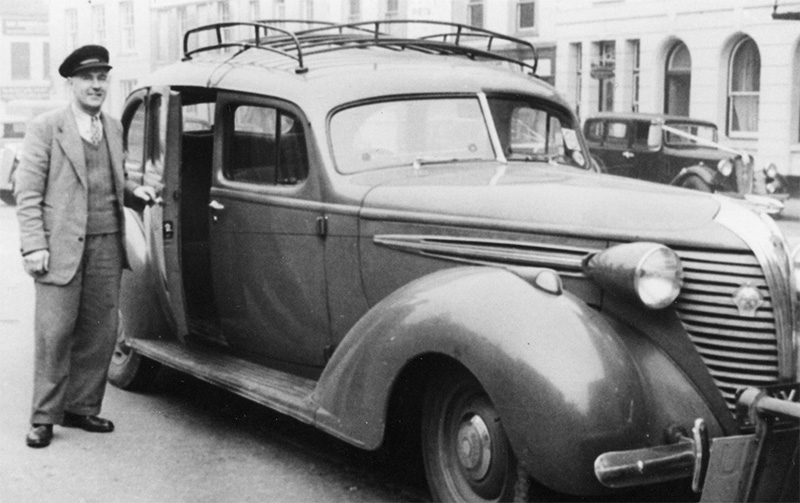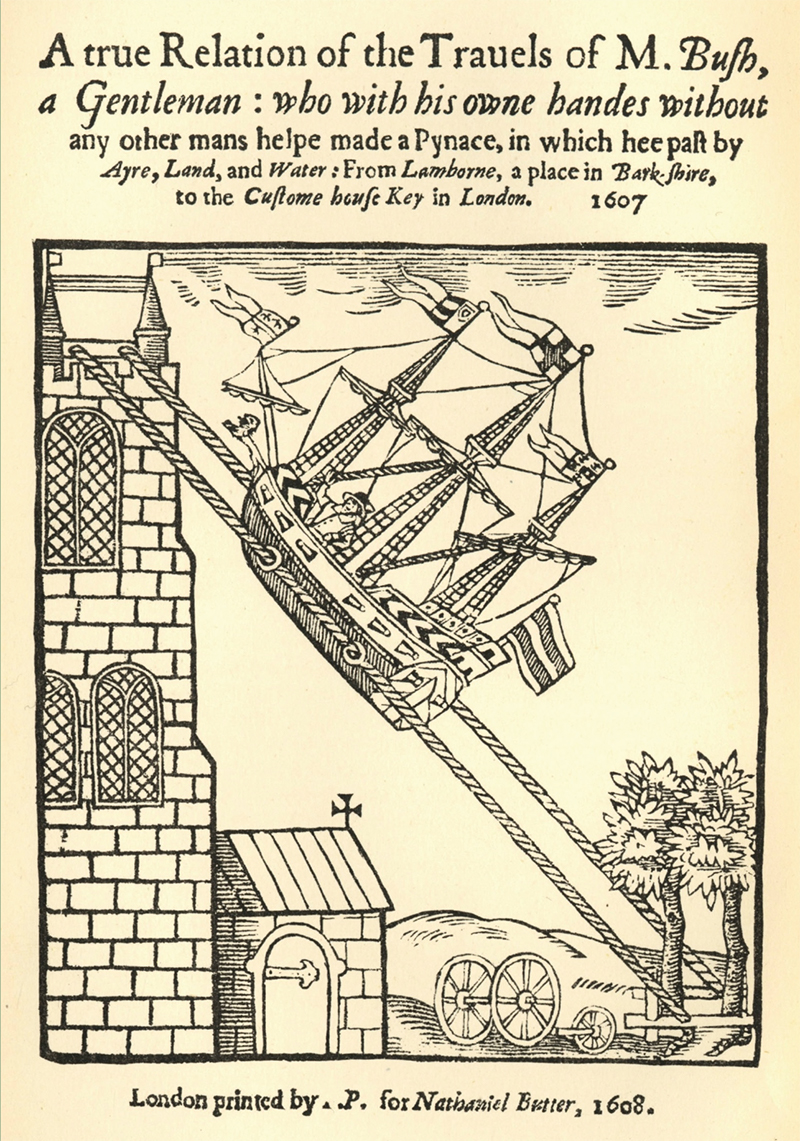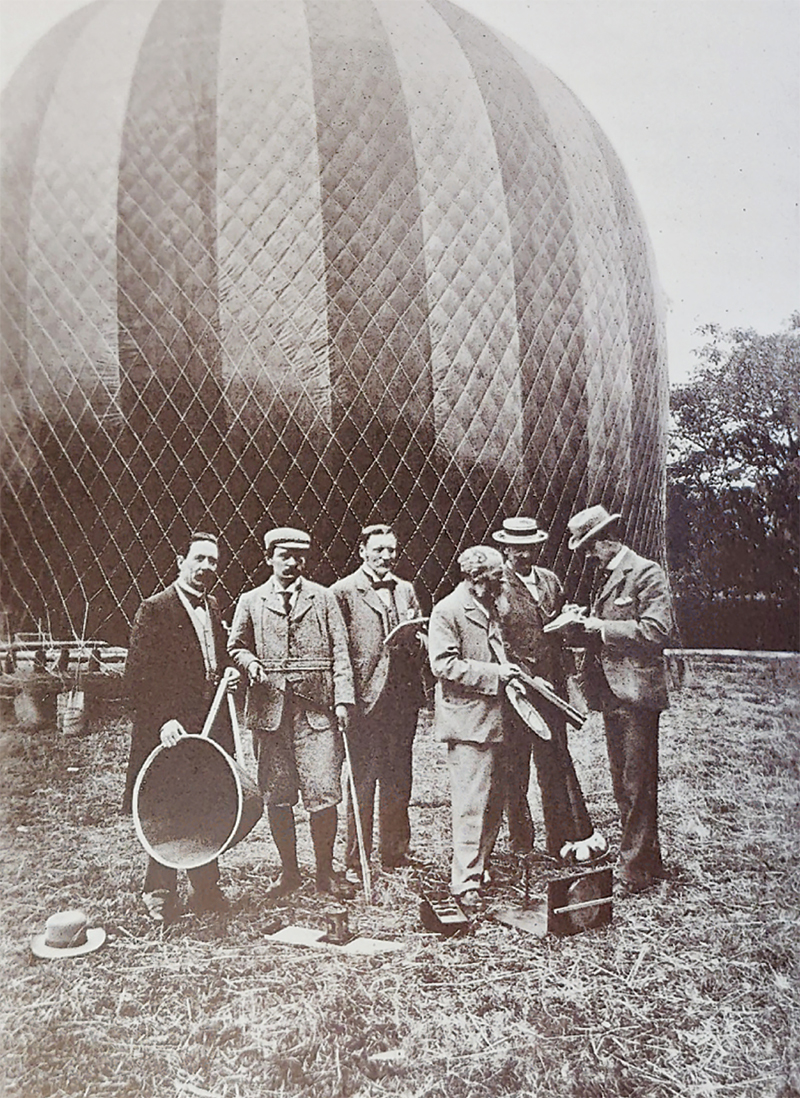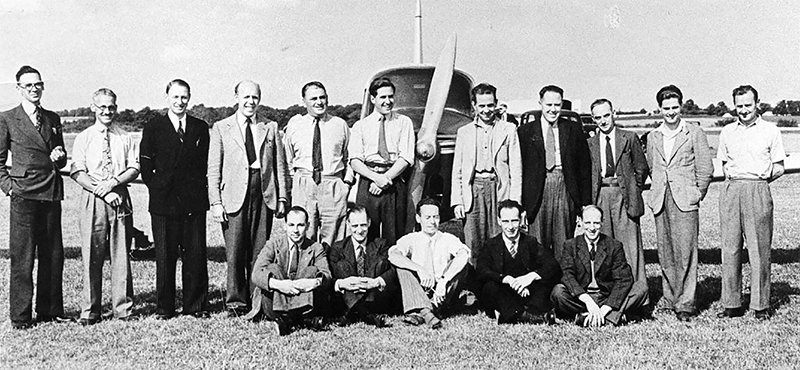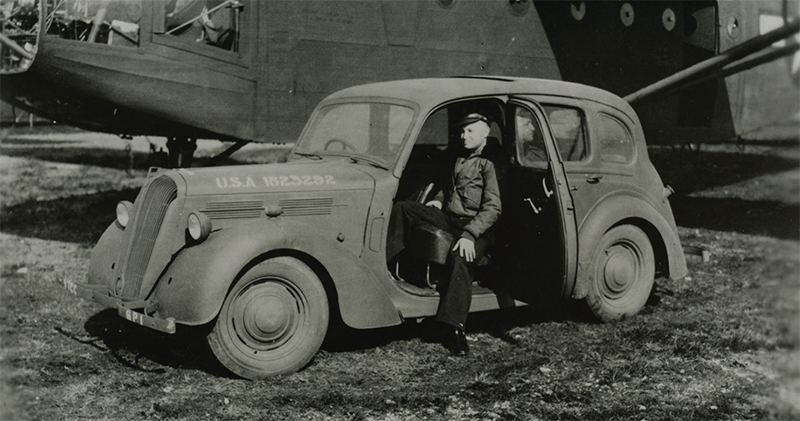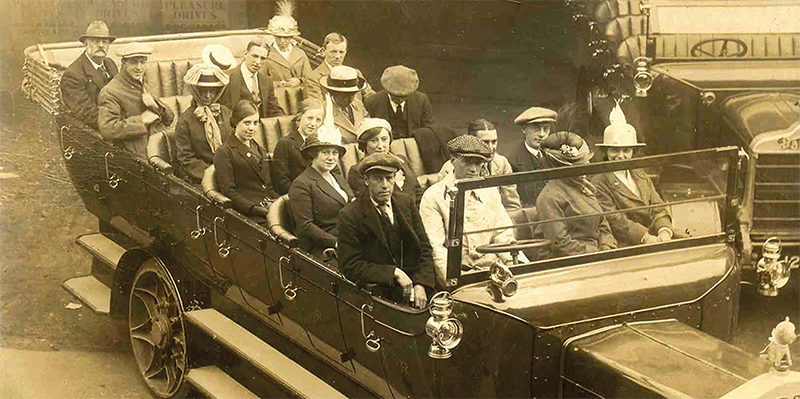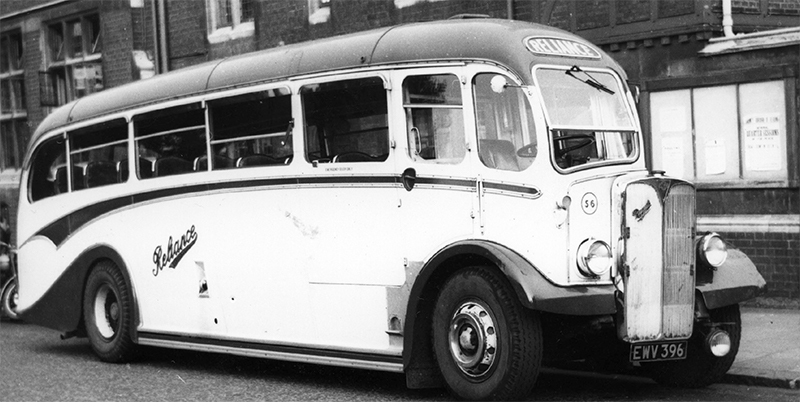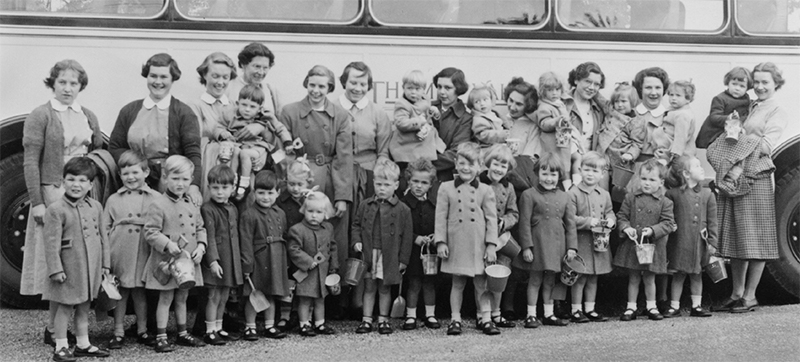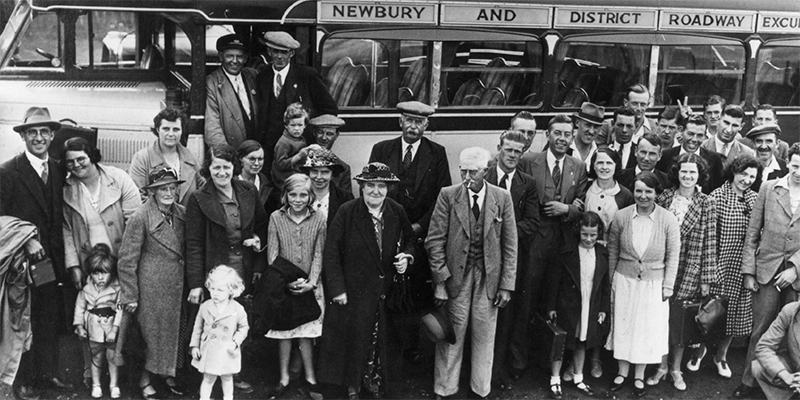Place to Place
Why do we move from place to place?
In this exhibition we look at how people of West Berkshire have travelled. We see how transport has developed and the effect this has had on people’s journeys in, out and around the area.
Some of the collections in the exhibition illustrate different modes of transportation, other objects have stories associated to them about the journeys their owners have taken and why.
Postcard of a biplane and its pilot, Jock Bonar, commemorating a five minute flight around Thatcham in 1936.
Making Tracks
For over 5000 years, people have been creating routes through the British landscape. The Ridgeway and Icknield Way are two of the oldest routes that cross the West Berkshire countryside and have helped communities get from one place to another in the most direct and safest way.
Ridgeways are ancient tracks that run along the high ridges of hills. They are unpaved but make use of hard ground to provide a surface suitable for travelling on. ‘The Ridgeway’ in England is described as the oldest road in Britain. It runs from Wiltshire, along the chalk of the Berkshire Downs to the River Thames. It has been used for 5000 years by many different groups of people; travellers, farmers, and armies. During Saxon and Viking times, the Ridgeway was useful to move soldiers into Wessex. In the Medieval period, the route was utilised by drovers, moving animals to market. The Ridgeway National Trail was designated in 1973. It is around 87 miles long linking Overton Hill near Avebury, Wiltshire, to Ivinghoe Beacon near Tring, Buckinghamshire.
There is an ancient trackway that connects Norfolk to the Dorset coast called the Icknield Way. The route follows the chalk ridge that includes the Berkshire Downs and Chiltern Hills. Icknield Way parallels the Ridgeway as a lowland route at the northern edge of the chalk. First mentioned in the Anglo-Saxon charters from 903 AD, it is one of the few long distance trackways to have existed before the Romans occupied the country. The route is thought to have been named after the Iceni tribe who established trade with other parts of the country from their base in East Anglia.
The Roman occupation brought new materials and made innovative developments in facilitating travel. The main Roman settlement in this area was called Calleva Atrebatum, now Silchester. Romans built roads that radiated out from Calleva towards Dorchester-on- Thames and St. Albans (along the Camlet Way), London (along the Devil’s Highway), Cirencester and Gloucester (along the Ermin Way) and Bath. The Roman road from Silchester to Bath went via Spinae (Speen), Cunetio and Verlucio (near Sandy Lane). This was a significant route for east-west travel and military logistics in southeast England during the 1st to 5th centuries.
Walkers and pony on a track near Walbury Hill, North Wessex Downs. Mid-late 20th century. Photograph taken by J. H. Hole.
‘Prospect of Newberry from the South between Winchester and Silchester Road’. Coloured engraving by Stukeley 28th June 1723.
Tracks to Turnpikes
Roman roads were designed so people and goods could be transported efficiently. The increase in coaching required building roads capable of handling heavy traffic. The introduction of Turnpike Trusts led to better maintained roads used for long-distance trading and leisure.
The Roman road network was built to connect key points by the most direct route possible. They were paved so that, as well as being used by soldiers and others to walk on, they could cope with heavy wagons for all-season trading. Roman roads remained in use for centuries after the Romans withdrew from Britain around 410 AD.
From 1555 to 1700, the responsibility for road maintenance was legally managed within each parish. Every male in the parish was required to provide 4-6 consecutive days’ free labour to repair the roads. This was resented and avoided whenever possible. Writers reported that Medieval roads were terrible, particularly in winter and wet weather.
18th century horse-drawn coaches needed better roads. Turnpike Trusts were set up to build and maintain roads in return for apayment. A turnpike was a gate used to bar a section of road until the traveller paid a toll to pass. Turnpikes were usually placed onlong, straight stretches of road, with identical milestones and occasional, decoratively built, toll houses. The law allowed a maximum toll for each class of vehicle or animal. Turnpikes were often resented by local people who had freely used the routes for centuries.
The earliest turnpikes in West Berkshire were on the Bath Road. The natural landscape made the east-west roads through Berkshire relatively easy to maintain and the high traffic flow provided ample income. The minor routes running north to south faced a more difficult landscape so there was less traffic. Trusts on this stretch, particularly the Aldermaston to Basingstoke Trust, were less financially stable.
In 1752 a Newbury firm, John Clark & Co., started a ‘flying coach’ service to Bath. The coach travelled at 4-5 mph taking only 12 hours. In 1820, 50 coaches each day passed along the Bath Road. However, road use declined from the 1830s due to the development of railways. Turnpikes were dismantled from the 1860s with the last Turnpike Trust ending in 1885. From 1889, local authorities took over responsibility for main roads.
Horses and wagon, James Copas Carman, Newbury. The Copas’ had a furniture business in Newbury. Late 19th century.
Waterways
Rivers formed the main transport links within Britain for hundreds of years before canals were built during the Industrial Revolution. By 1750 there were around 1000 miles of navigable river that boats could use. By 1850, this had grown to 4,250 miles. The waterways brought goods, trade and business to West Berkshire’s towns and helped them grow and prosper.
From the end of the Roman occupation until the middle of the 18th century, rivers were the main way of moving goods around Britain. The Romans improved rivers in Britain with embankments and probably ‘cut’ the Fossdyke to link the Trent and Witham rivers. The River Thames runs along the eastern border of West Berkshire in Pangbourne and Streatley. As the main water route across southern England, the Thames provided links between the Kennet & Avon, Thames & Severn and Grand Union Canals.
To make rivers navigable by boat, it was often necessary to build a flash lock or staunch using boards or gates that could be closed to raise the water level. A natural development was a pound lock with gates at both ends. Early canals closely followed the lie of the land to reduce the number of locks needed.
The Kennet & Avon Canal was created to link London and Bristol and used a combination of river and canal ‘cuts’. It was built in three stages beginning with the Kennet Navigation in 1723 and was fully opened in 1810. This gave Newbury, the wharf and store buildings good transportation links with London. Around the same time the River Avon was re-opened to barges from Bristol to Bath after being navigable in the Middle Ages but later blocked by water mills. The Kennet Navigation flourished for nearly 90 years and made Newbury the inland port for the area.
Canals were used to transport food, produce and raw materials across the country cheaply and efficiently. Tunnels, aqueducts, embankments and cuttings were designed to allow shorter level canals, and flights of locks were built to climb over hills, enabling a network of waterways to expand across the country. Boatmen’s wages were low and so it did not matter if the route was long and winding. However, once the railways opened, there was more competition on cost and service.
John Gould’s boats, Colin & Iris above Newbury Bridge. November 1949. Photograph taken by Miss Helen Purvis.
Branching Out
During the 1840s and 1850s, the popularity of stagecoaches fell due to the rapidly increasing railways. The rail network became critical to the Industrial Revolution and grew over the next 100 years, changing the landscape and the speed at which people and goods travelled.
By the 1900s there were three lines that passed through Newbury Station; the Berks and Hants Railway, The Didcot, Newbury and Southampton Railway and the Lambourn Valley Railway. The main branch line, Berks and Hants, was managed by the Great Western Railway (GWR), however, the smaller branch lines were constructed and run by independent companies. They were built to serve the high demand from local communities.
The Lambourn Valley Railway started with an earlier scheme in 1873 to link Newbury to Lambourn with a horse-drawn tramway. It was considered to be a cheaper way to transport coal than by turnpike roads. In 1881 the scheme developed into a railway and the line was opened in April 1898. The line encouraged travel by arranging combined rail and coach excursions from London to Lambourn, which included lunch, tea and a drive to see local points of interest. The GWR later purchased the line as it saw a potential to capture more racehorse traffic from other branches. This later became its main income with several thousand horses being transported a year.
The Didcot, Newbury and Southampton Railway ran north to south serving local communities and carrying trains from the Midlands to the south coast. During the First World War, this line provided essential transportation for troops to Winchester, which was the main assembly point for travel to France. The branch became key again in the Second World War and the Berkshire stretch was doubled in 1942. It is estimated that around 10,000 military trains used this line in the year leading up to D-Day.
The smaller routes continued to use steam or diesel traction engines. Over time, roads improved and more people used cars. The small branches struggled to make a profit and had to close, most disappeared by the mid- 1960s. The main lines throughout the country continued and rolled out electric trains in the 1960s and 1970s.
A GWR steam propelled coach, carrying 70 passengers, running on Lambourn Valley line just after this was acquired by the Company.
Newbury Railway Station, 1910. Newbury opened a railway station on the Berks and Hants Railway on 21st December 1847.
Wheels of Ingenuity
The bicycle gave people freedom to travel independently. The car redefined travel with speed and later comfort. With the many different forms of wheeled vehicles, human ingenuity has continued to find new ways in which we can move between places more efficiently.
Newbury’s own cycling pioneer was Robert Martin. He was the first bicycle dealer and first man to be seen locally on a ‘bone-shaker’, usually made from a wooden bar mounted on two iron wheels. It was around 1888 that the modern bicycle appeared in Newbury. Saddles could be swapped for a flat wooden seat for women to keep their modesty. The Corn Exchange developed courses to teach women how to ride in a ‘modest’ way, however, more daring ladies chose to cycle in bloomers instead.
Steam-power was used by emergency services and companies to improve efficiency for the delivery of their products. Town Mills yard at Newbury housed the depot for the Sentinel steam lorries used by Hovis to transport bulk wheat. Newbury Volunteer Fire Brigade used a steam powered fire engine to attend fires.
In 1900, around 50 motor cars passed through Newbury on their first lap of a Thousand Mile Trial, organised by the Automotive Club. The event was to convince the public that the car had a future. People would have marvelled at the rare sight of the motor vehicle and its speed at 8 miles an hour. Canon Cameron owned the first motor car in Stratfield Mortimer. The first petrol filling station to open in Britain for AA members was located in Aldermaston. This station operated from 1919 until about 1925 when it was sold, along with other AA stations. The site is now a lay-by on the A4 Bath Road.
In the early 1950s, enterprising local men obtained a ‘Hackney Licence’ to become Newbury’s first taxi drivers. Taxis gave people another option of travelling from their home directly to their destination. The taxi rank telephone for Newbury was in a grey box on the side of the Corn Exchange and the first driver in the rank would answer the call.
A Hovis steam-powered lorry taking up water from the Kennet and Avon Canal, 1930s. Hovis owned Town Mills and West Mills, Newbury, from 1921 to 1957.
Grace Winsor cycling down St. George’s Avenue in Newbury. Grace and her father were keen cyclists and would cycle from Newbury to Hayling Island, near Portsmouth and back in a day.
Norman Townsend standing by one of his taxis in Market Place. He ran a haulage business from his garage in Kiln Road, Newbury. He had up to 3 open-backed lorries and 4 taxis and was one of only three people in Newbury to hold a Class A type licence allowing him to carry any material.
Up, Up and Away
The 18th and 19th centuries saw major investment into the research and development of air transportation.West Berkshire has seen many pioneers in aviation, people who have pushed boundaries for scientific advancement and for travel.
In 1607, William Bush built and launched a machine from Lambourn church tower. This machine was a combination of boat, tricycle and balloon. It travelled overland to Streatley and down the Thames to London. The ingenious invention was guided down the tower by ropes and reportedly left gouge marks in the stone, which can still be seen. The voyage was eventful, problematic and took over a month to complete.
John Mackenzie Bacon and Gertrude Bacon, father and daughter, made some spectacular journeys in ballooning. John was born June 1846 in Lambourn Woodlands. He resigned from his position of clerical assistant to the Rector of Shaw in 1889 to devote his life to astronomy and aeronautics. Gertrude also became an aeronautical pioneer and assisted her father on many balloon ascents. She became the first Englishwoman to fly, as a passenger, in an aeroplane, an airship, a biplane, a seaplane and on a commercial flight between capital cities.
Geoffrey de Havilland was an aviation pioneer and an aerospace engineer. In 1910, he built a new biplane and flew it for the first time in a meadow near Newbury. His designs became very successful; the ‘Mosquito’ is considered the most versatile warplane ever built and the ‘Comet’ was the first commercial jet airliner.
Between the First and Second World Wars, aviation captured the imagination of entrepreneurs who found ways to use surplus military machines to introduce the thrills of flying to the masses. Companies hired fields from local farmers and travelled to give displays and offer flights to those who came to watch; they became known as the ‘flying circus’ or ‘barnstormers’. Berkshire Aviation Ltd. was one of these and operated out of Newbury and East Hanney.
Hilary Charles Nicholas ‘Nick’ Goodhart was an aviator born in Inkpen. He joined the Royal Navy and invented an optical landing system for pilots in 1954. He became World Gliding Champion in 1956 and held 11 British records over his gliding career.
Illustration of the machine built by William Bush. From History of Lambourn Church by John Footman, 1894.
John Bacon’s first scientific balloon ascent from Shaw House, Newbury on 27th July 1898. Photograph taken by Gertrude Bacon.
First flight of the Newbury Eon, by Elliotts of Newbury, 1947. The glider was considered the world’s finest light aircraft but was unfortunately never mass produced. Image courtesy of Central Press Photos Ltd.
Captain Tom R. Shalcraft in his car, beside a CG-13 glider, Crookham Common aerodrome, 1944. From an album of photographs made by John Brown, then aged 15, and a frequent visitor to the aerodrome during the first half of 1944.
Heydays & Holidays
The term ‘holiday’ comes from the Medieval term ‘holy day’. In addition to religious observation, this time meant people could relax away from work. The Industrial Revolution saw an increase in workers’ rights and welfare. This alongside the growth of affordable road and rail transportation allowed people to travel to new places for leisure and exploration.
In the 16th and 17th centuries it became common for wealthy young men to travel abroad on a grand tour of Europe. A grand tour could take many years and include the most famous places in Europe. This was not an opportunity for most, but it raised awareness of new and exciting places to travel. Workers at this time had limited days off. Wakes Week was originally a religious period of celebration and in England, during the Industrial Revolution, was developed into a regular holiday.
The development of railways led to towns like Blackpool, Southport and Morecambe growing into resorts. They catered for the working class who believed that bathing in the sea during August and September was good for the health. Spa towns such as Bath and Tunbridge Wells flourished through visitors drinking and bathing in the natural spa water to cure illnesses. Special trains ran to facilitate high numbers of passengers during Wakes Week.
In 1871 the Bank Holiday Act gave workers a few paid holidays per year in addition to every Sunday. By the 1890s most workers were then given half a day holiday on Saturday, which was the start of the ‘weekend’ as we know it. Charabancs were a popular choice of transport for workers’ short-trips and day excursions. They were usually adult only and occasionally paid for with the assistance of the factory or mill. Companies that ran commercial horse-drawn stagecoaches also operated charabancs and then superseded them with larger motor coaches.
Between 1900 and 1950, there were approximately 100 small companies that were operating coaching services in West Berkshire. Some of these companies included Durnford & Sons, Denham Bros, P.A.Andrews, G.Hedges, J. Prothero, T.Holman, Pocock & Sons and F.Spanswick, which were amalgamated into Newbury and District Motor Services in 1932.
Reliance Coach outside Post Office, 1930s. Reliance Motor Services operated in and around Newbury from 1917 to 1985, using horse-drawn carriers at first and then large coaches. Reliance ran day trips to Southsea throughout the 20th century.
St Mary’s Children’s Home, Cold Ash, on their annual seaside outing, probably to Littlehampton and Sandbanks, in July 1956.
